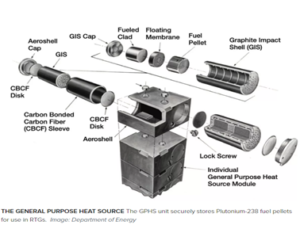
CWP Blog | CWP
Talk to Terrie: DOE and the Final Frontier
November 17, 2021
November 17, 2021
CWP
CWP Blog
By working with advocates for the workers at the Santa Susana Field Laboratory (SSFL), I’ve known for quite some time that the Department of Energy (DOE) and the National Aeronautics and Space Administration (NASA) worked closely together to develop the space exploration program. What I didn’t know is exactly what role DOE played. NASA tested rockets in SSFL’s Area II.
NASA was formed in 1958 and the collaboration began almost immediately with NASA contracting with the Savannah River Site to convert neptunium into the non-weapons grade Plutonium-238.
P-238 was and still is used to power the radioisotope power systems (RPS). The RPS contains a small pellet of P-238, the size of a pencil eraser, and converts the heat given off by the decay into electrical power. These power systems are considered to be more reliable than solar batteries since they can generate electricity while in the far reaches of a cold and dark outer space.
NASA used this power generating system in many of its space craft. The first time it was used was in 1961 when the Transit IV-A satellite was launched on July 29. This type of power system went to the moon, Mars, and has even powered the Pioneer missions traveling deep into our solar system. The Pioneer power systems lasted over 22 years until NASA lost communication with the satellites.
Many DOE sites besides SRS participated in the research into this power system. Most of the National Laboratories provided the research. The Mound Site and Hanford were involved with this project. There may be other DOE sites who were involved with the production of this generating system.
DOE continues to fund research to power space craft. Want to know what one area of research is? It’s the “New and Improved Antimatter Spaceship for Mars Missions”! Anyone who likes science fiction knows that any self-respecting spaceship is usually powered by antimatter. The character, Scotty, on the original Star Trek television show warned Captain Kirk that, “You can’t mix matter and antimatter cold!”
The research into using antimatter for a propulsion system is not some wishful but unattainable idea. DOE scientists from the Lawrence Berkeley National Laboratory had a part in trapping and storing antimatter! Fermi National Laboratory also produces and stores antimatter.
We don’t yet have the technology to produce antimatter in large quantities (Fermilab produces the largest amount of antimatter of any laboratory of the world, and yet it is only a milligram per year). And storing antimatter is a tricky business as you need to keep it from touching regular matter. (At present, scientists use magnetic fields to trap and store antimatter in vacuum vessels or storage rings.)
Amazing.
